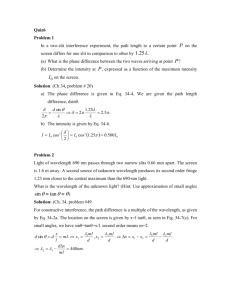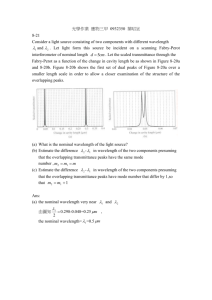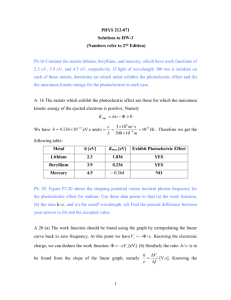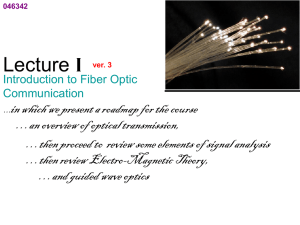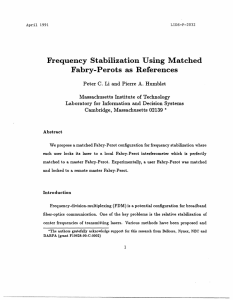Homework #3 Solutions
advertisement
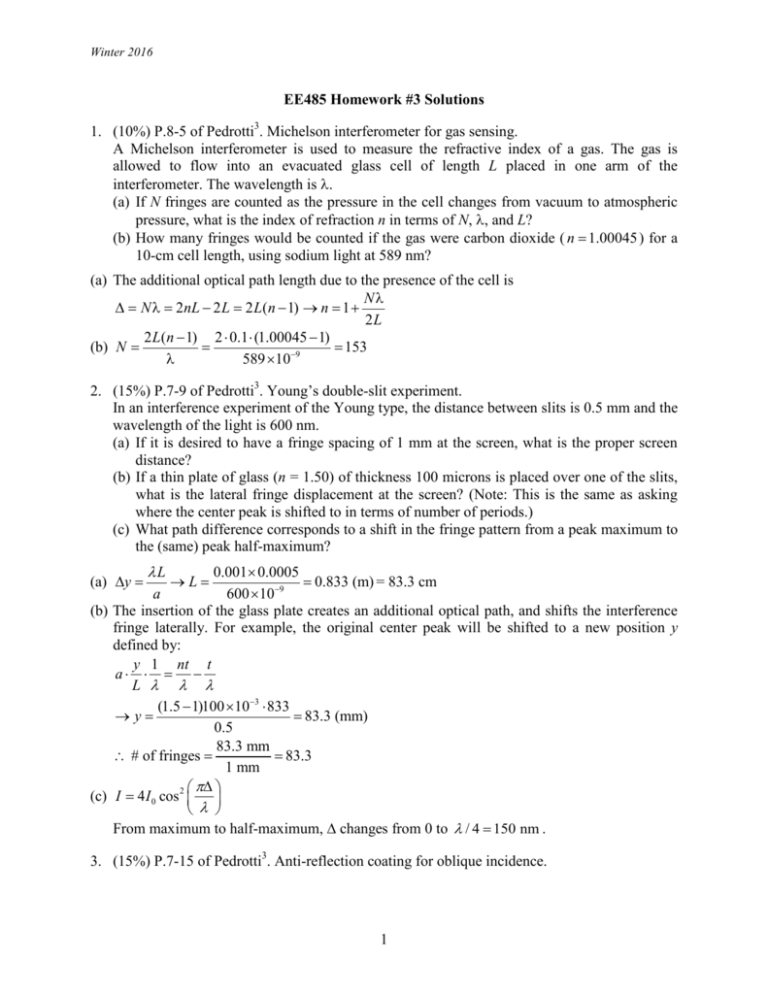
Winter 2016 EE485 Homework #3 Solutions 1. (10%) P.8-5 of Pedrotti3. Michelson interferometer for gas sensing. A Michelson interferometer is used to measure the refractive index of a gas. The gas is allowed to flow into an evacuated glass cell of length L placed in one arm of the interferometer. The wavelength is λ. (a) If N fringes are counted as the pressure in the cell changes from vacuum to atmospheric pressure, what is the index of refraction n in terms of N, λ, and L? (b) How many fringes would be counted if the gas were carbon dioxide ( n = 1.00045 ) for a 10-cm cell length, using sodium light at 589 nm? (a) The additional optical path length due to the presence of the cell is Nλ ∆= N λ= 2nL − 2 L= 2 L(n − 1) → n =1 + 2L 2 L(n − 1) 2 ⋅ 0.1 ⋅ (1.00045 − 1) = = 153 (b) N = λ 589 ×10−9 2. (15%) P.7-9 of Pedrotti3. Young’s double-slit experiment. In an interference experiment of the Young type, the distance between slits is 0.5 mm and the wavelength of the light is 600 nm. (a) If it is desired to have a fringe spacing of 1 mm at the screen, what is the proper screen distance? (b) If a thin plate of glass (n = 1.50) of thickness 100 microns is placed over one of the slits, what is the lateral fringe displacement at the screen? (Note: This is the same as asking where the center peak is shifted to in terms of number of periods.) (c) What path difference corresponds to a shift in the fringe pattern from a peak maximum to the (same) peak half-maximum? λL 0.001× 0.0005 = 0.833 (m) = 83.3 cm a 600 ×10−9 (b) The insertion of the glass plate creates an additional optical path, and shifts the interference fringe laterally. For example, the original center peak will be shifted to a new position y defined by: y 1 nt t a⋅ ⋅ = − L λ λ λ (1.5 − 1)100 ×10−3 ⋅ 833 = →y = 83.3 (mm) 0.5 83.3 mm ∴ # of fringes = = 83.3 1 mm π∆ (c) I = 4 I 0 cos 2 λ From maximum to half-maximum, ∆ changes from 0 to λ / 4 = 150 nm . (a) ∆y= → L= 3. (15%) P.7-15 of Pedrotti3. Anti-reflection coating for oblique incidence. 1 Winter 2016 A thin film of MgF2 (n = 1.38) is deposited on glass so that it is antireflecting at a wavelength of 580 nm under normal incidence. What wavelength is minimally reflected when the light is incident instead at 45⁰? (Note: It is tempting to think that the path difference for the two waves is t / cos θt , where t is thickness of the glass and cos θt is the propagation angle of the wave after entering the glass. But this is incorrect! Please read the text associated with Figure 7-12 for a correct approach.) At normal incidence, 1λ = 2t m + , λ = 580 nm 2 n At 45º incidence, 1λ' 2t cos θ = t m+ 2 n Using Snell’s Law, 1 sin = 45° 30.824° → cos = = θt sin −1 θt 0.859 1.38 ∴ λ ' = λ cos θt = 580 ⋅ 0.859 = 498.22 nm 4. (20%) Mach-Zhender fiber demultiplexer. Consider a Mach-Zehnder fiber demultiplexer depicted in Figure 10-16b. Assume that n = 1.5. (a) Find a difference in path length between the two arms of the fiber interferometer ∆L that will efficiently demultiplexing a signal containing wavelength components λ1 = 1551.2 nm and λ2 = 1550.4 nm. Assume that the λ1 component exits through Output 1. (b) If the path length difference is as found from part (a), though which output port would light of wavelength λ3 = 1552.0 nm exit the interferometer? (c) If the path length difference is as found from part (a), find the ratio of intensity exiting through the two output ports if the input signal has a wavelength of 1550.8 nm. (a) The conditions to be satisfied are ∆L= m λ1 1λ = m + 2 . n 2 n −1 1 1 1 1 λ1λ 2 = ∆L − = 2n λ 2 λ1 2n λ1 − λ 2 ∆L 1 λ2 ∆L 1 λ1 , = = λ 2 / n 2 λ1 − λ 2 λ1 / n 2 λ1 − λ 2 λ1 λ = ∆L 969= 969.5 2 . 1.5 1.5 λ1 ∆L 1551.2 (b) Since = 969 = 969 = 968.5 is close to an integer +1/2, this light will exit λ3 / n λ3 1552 primarily through Output 2. 2 Winter 2016 I in [1 + cos(k ∆L)] 2 I in I [1 + cos(k ∆L + = I Port = π)] in [1 − cos(k ∆L)] 2 2 2 ∆L 969 ⋅ 1551.2 2π = 2π ≈ 969.25 ⋅ 2π λ 1550.8 I Port 1 1 + cos(0.5π) ≈ = 1 I Port 2 1 − cos(0.5π) (c) I Port 1 = 5. (20%) P.8-21 of Pedrotti3. Fabry-Perot interferometer for discerning two wavelengths. Consider a light source consisting of two components with different wavelength λ1 and λ2. Let light from this source be incident on a scanning Fabry-Perot interferometer of nominal length d = 5 cm. Let the scaled transmittance through the Fabry-Perot as a function of the change in the cavity be as shown in Figure (a) and (b) below. Figure (b) shows the 1st set of dual peaks of Figure (a) over a smaller length scale in order to allow a closer examination of the structure of the overlapping peaks. (a) What is the nominal wavelength of the light source? (b) Estimate the difference λ2 - λ1 in wavelength of the two components presuming that the m= m. overlapping transmittance peaks have the same mode number, m= 2 1 (c) Estimate the difference λ2 - λ1 in wavelength of the two components presuming that the m1 + 1 . overlapping transmittance peaks have mode numbers that differ by 1, so that m= 2 mλ , 2d= (m + 1)λ (a) 2d= 1 2 → (d 2 − d1 ) = λ/2 → λ = 2(d 2 − d1 ) = 2 ⋅ 0.25 =0.5 m m = λ1 , 2d12 mλ2 (b) 2d11 m= m ≈ 2d / λ , where d is the nominal length 5 cm, and λ is the nominal wavelength 0.5 mm. 2(d − d ) (d − d ) 0.002 ×10−6 λ2 − λ1 = 12 11 = 12 11 λ ≈ × 0.5 =2 ×10−8 mm m d 0.05 2d12 2d11 2md12 − 2(m + 1)d11 2m(d11 + ∆d ) − 2(m + 1)d11 (c) λ2 − λ1= − = = m2 m1 m(m + 1) m(m + 1) m is a very large number, therefore m(m + 1) ≈ m 2 . 3 Winter 2016 ∴ λ2 − λ1 ≈ 2m∆d − 2d11 ∆d λ2 0.52 −8 ≈ λ − =× 2 10 − = −2.5 ×10−6 mm 2 4 m d 2d 2 ⋅ 5 ×10 6. (20%) Phase/group velocity and dispersion in an optical fiber. Assume the dispersion curve of an optical fiber can be represented by the refractive index B variation of pure silica n(λ) = A − Bλ 2 + 2 for wavelength ranges between 0.6 mm and 1.6 λ mm, λ in µm. (a) Refer to the figure on slide 19 of the supplemental notes (you can use n(1.0 mm)=1.45 and n(1.6 mm)=1.443), determine A and B. (b) Use the result from (a), find the phase and group velocity of light at 1.55 mm. (c) Calculate the dispersion coefficient Dλ in ps/km-nm at λ = 1.55 µm. (d) If a laser pulse with 2 nm bandwidth has an original pulse width of 10 ps, determine the final pulse width after transmitting through the optical fiber for 100 km. What is the maximum 3dB bandwidth the transmission system can have? (You can see from this example that high-speed long-haul optical fiber communication is not possible without dispersion compensation.) (a) From the figure, n(1.0) = A − B + B = 1.45 n(1.6) = A − B ⋅ 2.56 + B = 1.443 2.56 → = A 1.45,= B 0.003 (b) n(1.55) =1.45 − 0.003 ⋅ 1.552 + = vp 0.003 =1.444 1.552 3 × 108 = 2.0776 × 108 (m/s) 1.444 −1 λ dn λ dn 3B 2 Group index N = n 1 + ≈ n 1 − = A + Bλ + 2 λ n d λ n d λ 8 3 × 10 , vg = 2.0534 × 108 (m/s) N (1.55) = 1.461= 1.461 2 d n B (c) At λ = 1.55 µm, = −2 B + 6 4 = −0.0029 (mm) −2 2 dλ λ 2 λd n Dλ = − ≈ 15 (ps/km ⋅ nm) c d λ2 (d) τ f 2 ≈ τ0 2 + (δτ= ) 2 102 + (15 × 2 × 100) 2 τ f ≈ 3001.7 ps ν max= 0.5 / τ= 0.167 GHz f 4
